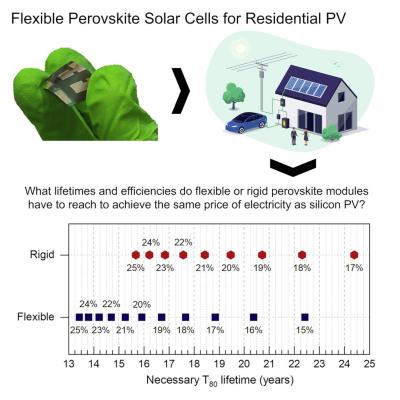An international research group that included teams from Vrije Universiteit Amsterdam, University of Fribourg, the University of the Basque Country and the University of New South Wales has assessed the levels of efficiency and stability that perovskite solar cells (PSCs) have to achieve in order to become an economically viable technology to compete with crystalline silicon cells in the rooftop segment.
The scientists assessed the necessary lifetime (LT) of a perovskite module, which they defined as the time until a module has 80% of its initial efficiency, as a function of efficiencies to be competitive in the levelized cost of electricity (LCOE). They found that perovskite solar modules might need to provide 20% efficiency for at least 36 years, or 25% efficiency for a minimum of 21 years, if they want to compete with conventional PV panels.
The team explained that this means that even with the significantly lower production costs of perovskites, it can be challenging to become competitive with silicon, mainly because of the low LT of current perovskite solar cells and the limited experience with perovskite module stability. However, perovskite technology may get a boost if academics and industry will be able to reduce its installation and structural balance-of-system (BOS) costs, as these usually account for around 10% of a PV system costs.
The team assumed a levelized cost of electricity for the United States of $0.119/kWh to $0.136/kW for residential PV systems based on conventional panels in 2021. Their estimates ranged from $0.055/kWh to $0.063/kW for the same installations in 2030.
Their analysis showed that by using flexible substrates, perovskite solar modules would need to achieve lower target efficiencies of 15% and LTs spanning from 13 to 22 years to compete with crystalline silicon in the 2021 scenario, and efficiencies of 17% and LTs spanning from 16 to 34 years in the 2030 scenario.


